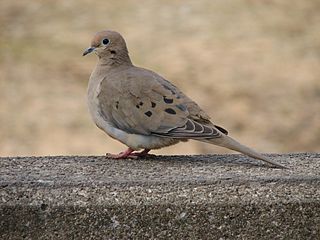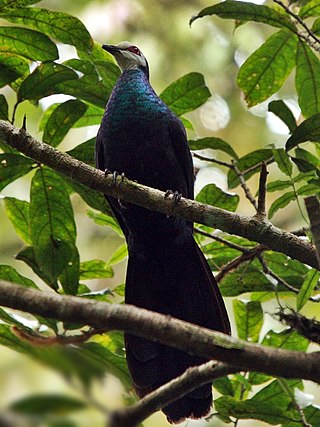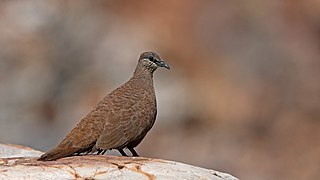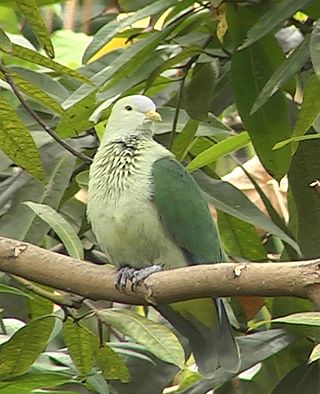
Streptopelia is a genus of birds in the pigeon and dove family Columbidae. These are mainly slim, small to medium-sized species. The upperparts tend to be pale brown and the underparts are often a shade of pink. Many have a characteristic black-and-white patch on the neck and monotonous cooing songs.

The zenaida doves make up a small genus (Zenaida) of American doves in the family Columbidae.

Turacoena is a small genus of doves in the family Columbidae that are found in Indonesia.

Chalcophaps is a genus of small doves, commonly called emerald doves, that are found in Indomalaya and Australasia.

Geopelia is a genus of small, long-tailed doves in the family Columbidae. They are native to South-east Asia and Australasia and are most often found in open country and scrubland. They feed mainly on seeds which they find by foraging on the ground. They typically lay two eggs in a simple nest of twigs and grass. Their plumage is mostly greyish-brown with a pattern of spots or bars. The zebra dove and diamond dove are commonly kept in captivity.

The orange fruit dove or orange dove is a species of bird in the pigeon family Columbidae. One of the most colorful doves, the male has a golden olive head and elongated bright orange "hair-like" body feathers. The golden-olive remiges are typically covered by the long orange wing coverts when perched. The legs, bill and orbital skin are bluish-green and the iris is whitish. The female is a dark green bird with blackish tail and orange-yellow undertail coverts. The young resemble females.

The blue pigeons are a genus, Alectroenas, of birds in the dove and pigeon family Columbidae. They are native to islands in the western Indian Ocean.

Geotrygon is a bird genus in the pigeon and dove family (Columbidae). Its members are called quail-doves, and all live in the Neotropics. The species of this genus have ranges from southern Mexico and Central America to the West Indies and South America. Quail-doves are ground-dwelling birds that live, nest, and feed in dense forests. They are remarkable for their purple to brown coloration with light-and-dark facial markings.

Leptotila is a genus of birds in the dove and pigeon family Columbidae. These are ground-foraging doves that live in the Americas.

Macropygia is a genus of bird in the pigeon and dove family Columbidae. The genus is one of three genera known as cuckoo-doves. They are long tailed, range between 27 and 45 cm in length and have brown plumage. The genus now ranges from India and China through Indonesia and the Philippines to Vanuatu and Australia, though they originated from North and South America.

Metriopelia is a genus of ground doves containing four species that live in the dry, upland habitats along the Andean mountain chain in South America. They have large wings and three species have orange skin around the eyes.

The white-quilled rock pigeon is a dark brown rock pigeon with a white patch on its wing. It has distinctive pale lines across its face curving above and below its eye. It is a species of bird in the family Columbidae. It is rock dweller found roosting on sandstone cliffs and towers in the Kimberley, WA and east of the Victoria River, NT. It is endemic to Australia.

Brown doves are members of the genus Phapitreron in the pigeon family. Their common name refers to their overall brown coloration. They are endemic to the Philippines. All brown doves are tree-dwellers, but the different species occupy different types of wooded habitats; some are more restricted to old-growth forest while other make use of secondary forest and other woodland. Their main diet is fruit. They tend to be solitary in their habits and can be elusive. Some species in this genus have conspicuous black and white stripes on their faces and iridescent neck feathers. Males and females look alike.

The white-headed fruit dove is a species of bird in the pigeon family Columbidae. It was described by the English ornithologist John Gould in 1856, and the specific name eugeniae honours the French empress Eugénie de Montijo. Adults of the species have white heads, a purplish-red breast patch, a grey shoulder patch, olive-green upperparts, greenish underparts with a blue tinge, and a yellowish vent. Juveniles have green heads with the white restricted to the forehead and upper throat, a much smaller grey shoulder patch, and the red breast patch restricted to the centre of the breast.

The grey-green fruit dove is a species of bird in the family Columbidae. It is endemic to the Society Islands in French Polynesia. Its natural habitat is subtropical or tropical moist lowland forests.

The blue-headed quail dove, or blue-headed partridge-dove, is a species of bird in the pigeon and dove family Columbidae. It is monotypic within the subfamily Starnoenadinae and genus Starnoenas.

The São Tomé green pigeon is a species of bird in the family Columbidae. It is endemic to the island of São Tomé in São Tomé and Príncipe. Its natural habitat is subtropical or tropical moist lowland forests. The species was described by Johann Friedrich Gmelin in 1789. They have disappeared from Ilhéu das Rolas due to habitat loss. There are around 10,000 pigeons of this species today.

The black cuckoo-dove, also known as the slaty cuckoo-dove, is a species of bird in the family Columbidae. It is endemic to the Lesser Sunda Islands, being found on Timor, Wetar, Rote, and Atauro. It inhabits primary and secondary monsoon forest, eucalyptus forest, and woodlands. It is 38.5 cm (15.2 in) long on average and is mainly dark bluish-gray, lighter on the head and underparts and darker on the wings and tail. It has yellow orbital skin.

Columbina is a genus of small doves in the family Columbidae that live in the New World. They range from the southern United States through Central America and much of South America. Columbina doves are normally found in pairs or small flocks and generally occur in open country. They have maroon irides and pinkish legs. In flight, some species show a distinctive flash of rufous in the wings, while others show black-and-white wing-patterns.

The fruit doves, also known as fruit pigeons, are a genus (Ptilinopus) of birds in the pigeon and dove family (Columbidae). These colourful, frugivorous doves are found in forests and woodlands in Southeast Asia and Oceania. It is a large genus with over 50 species, some threatened or already extinct.




















